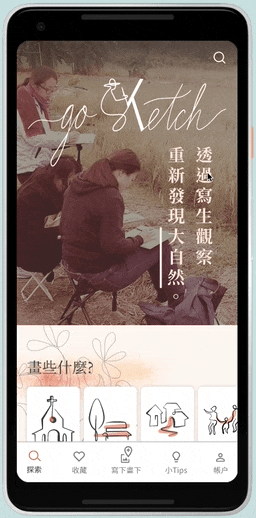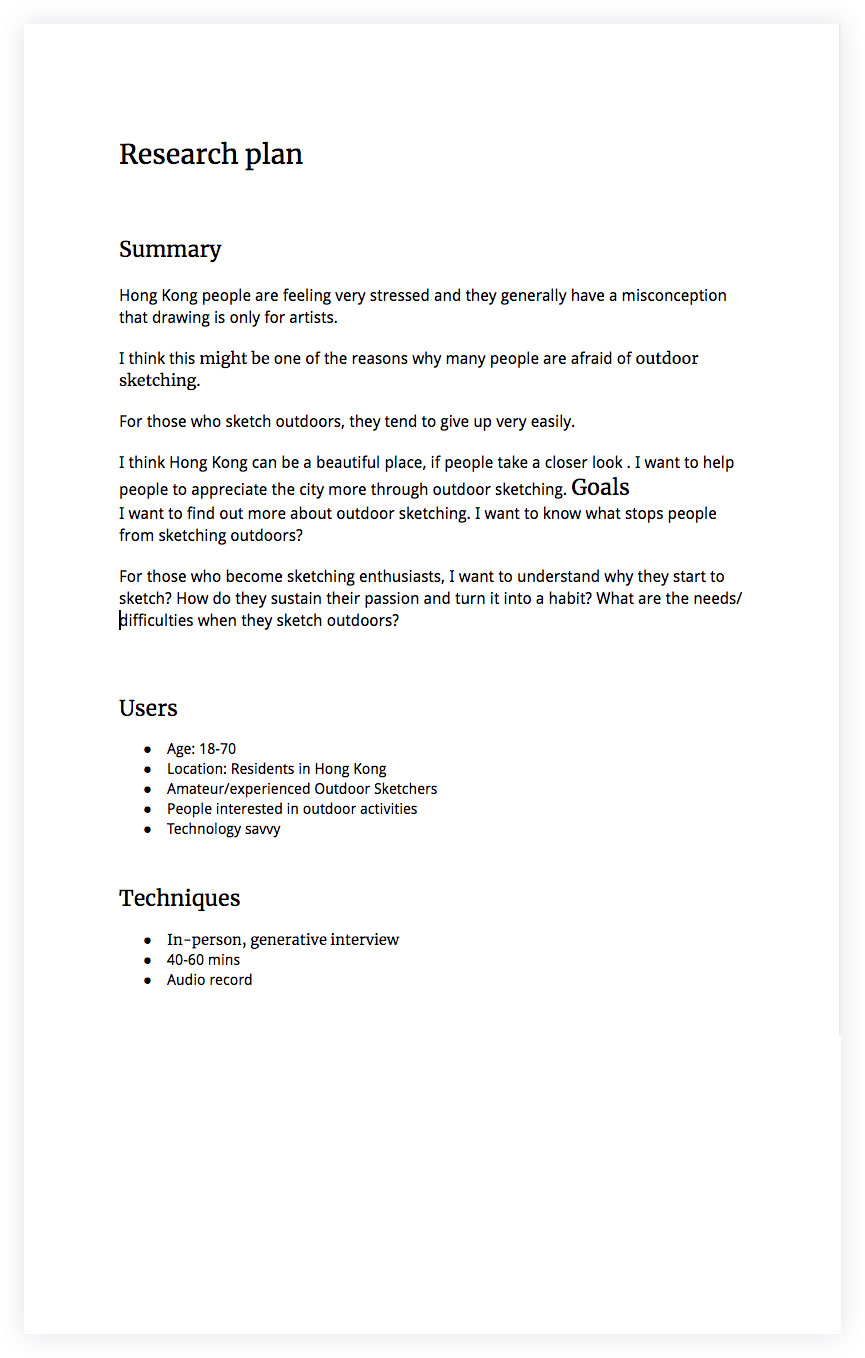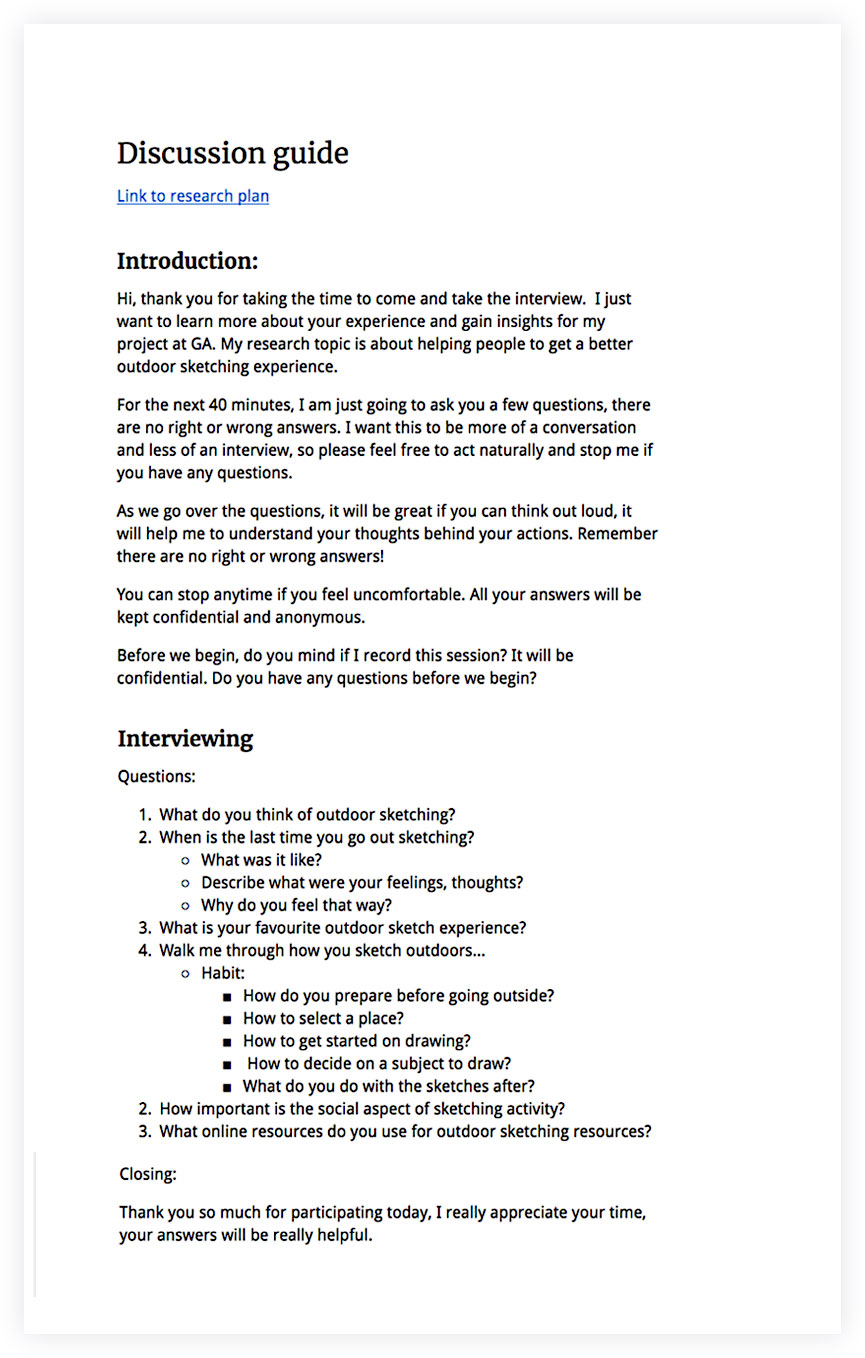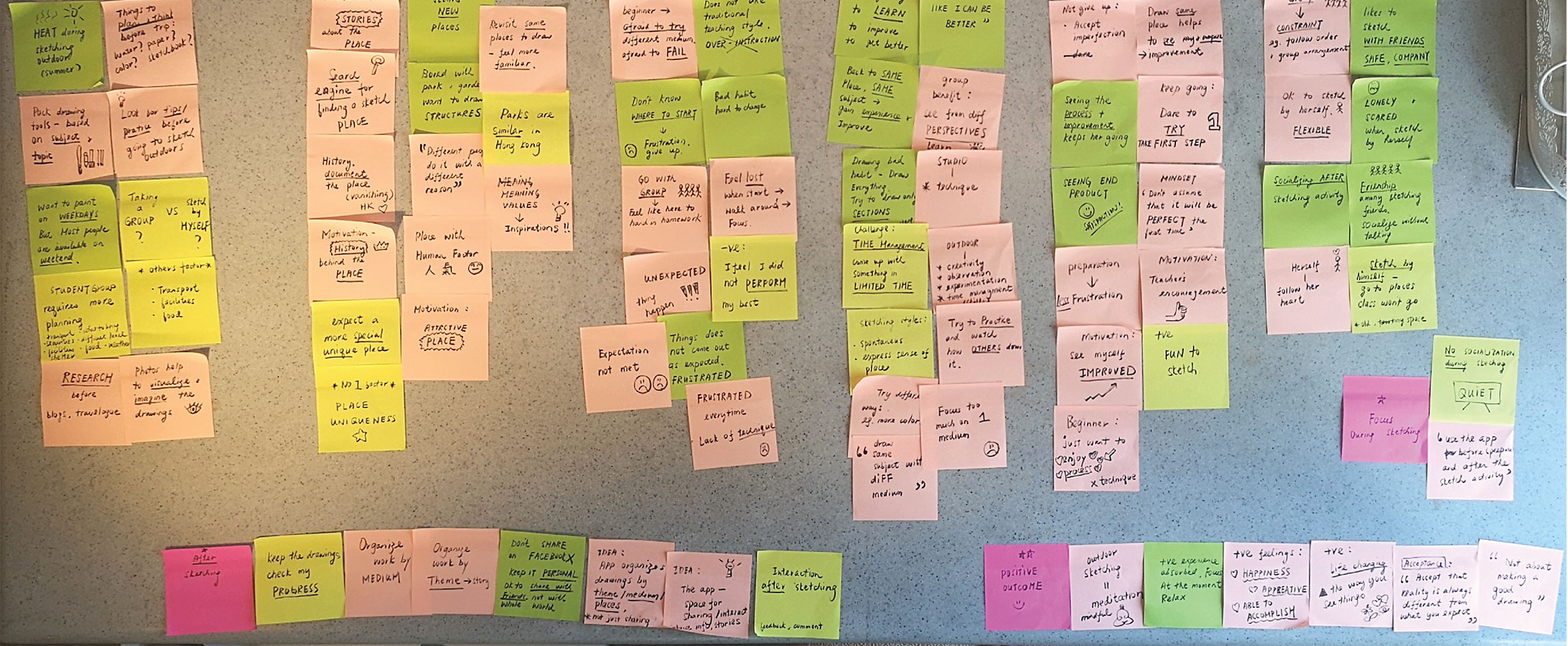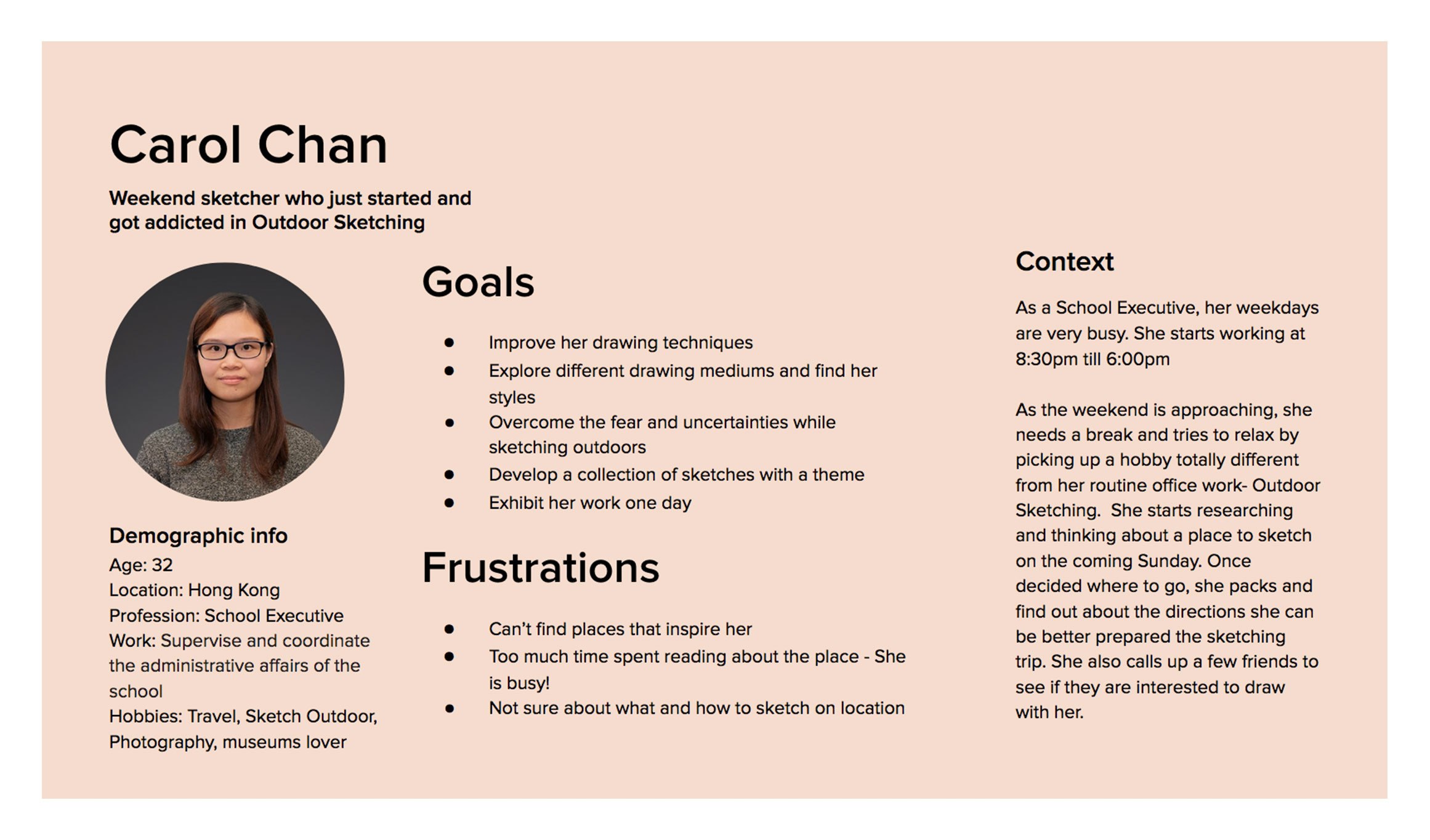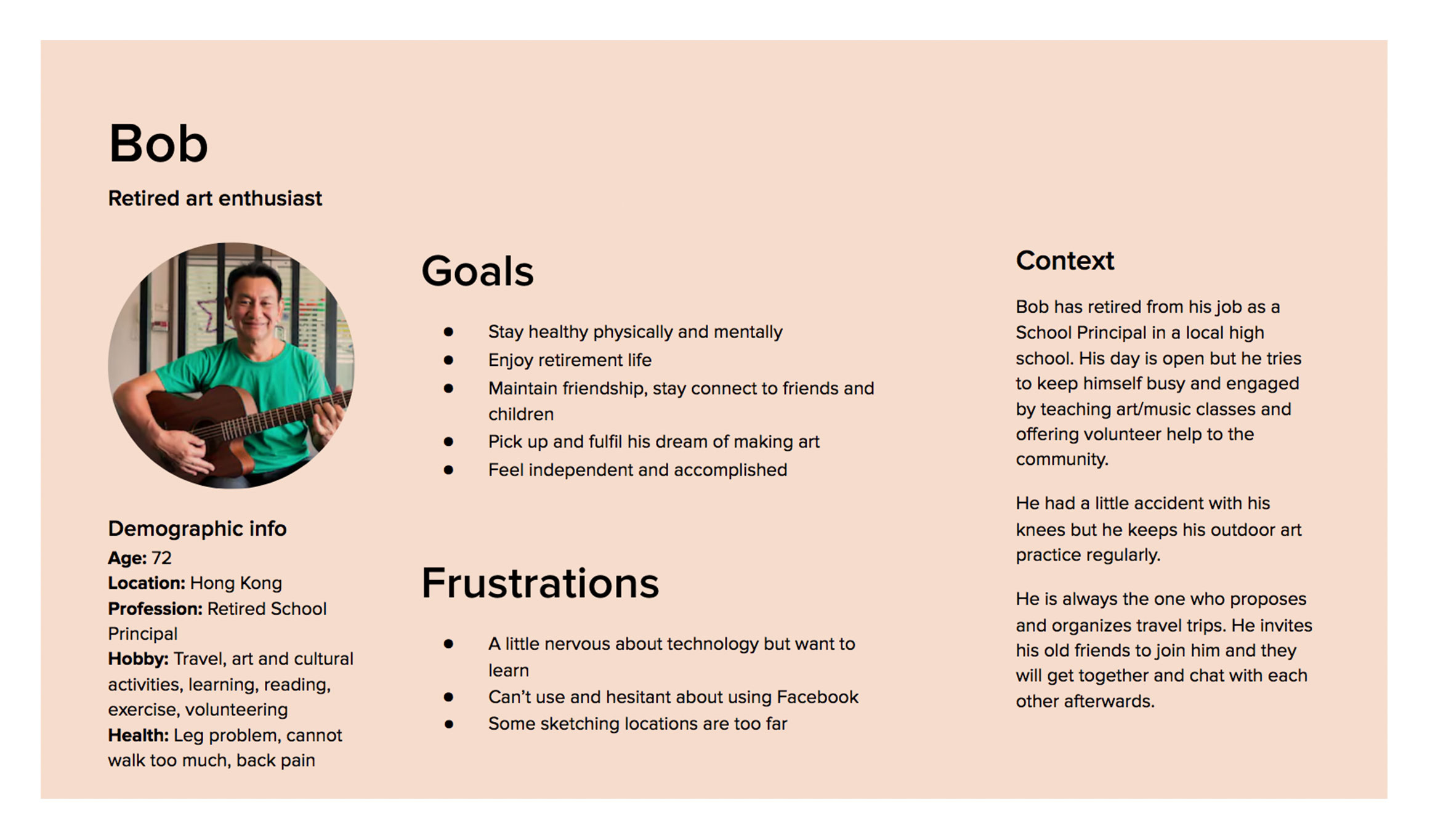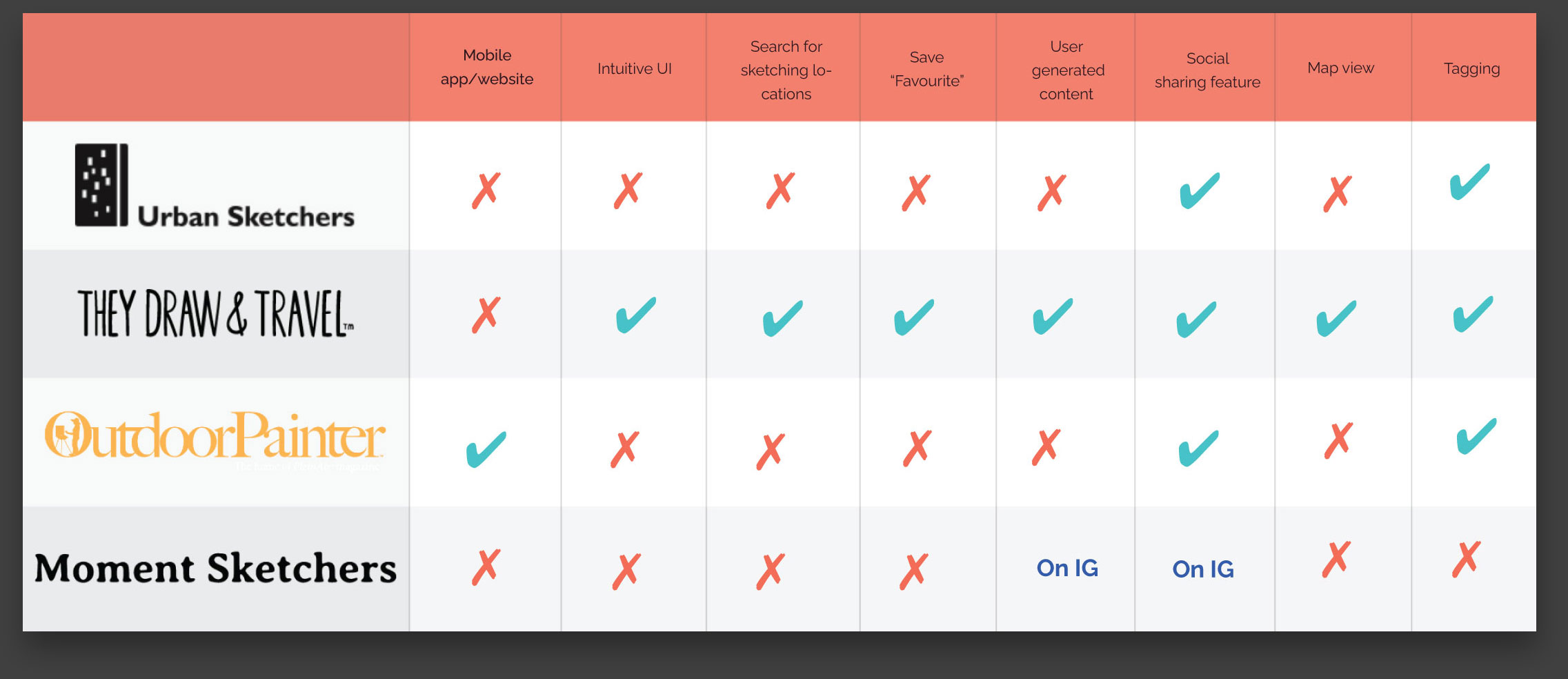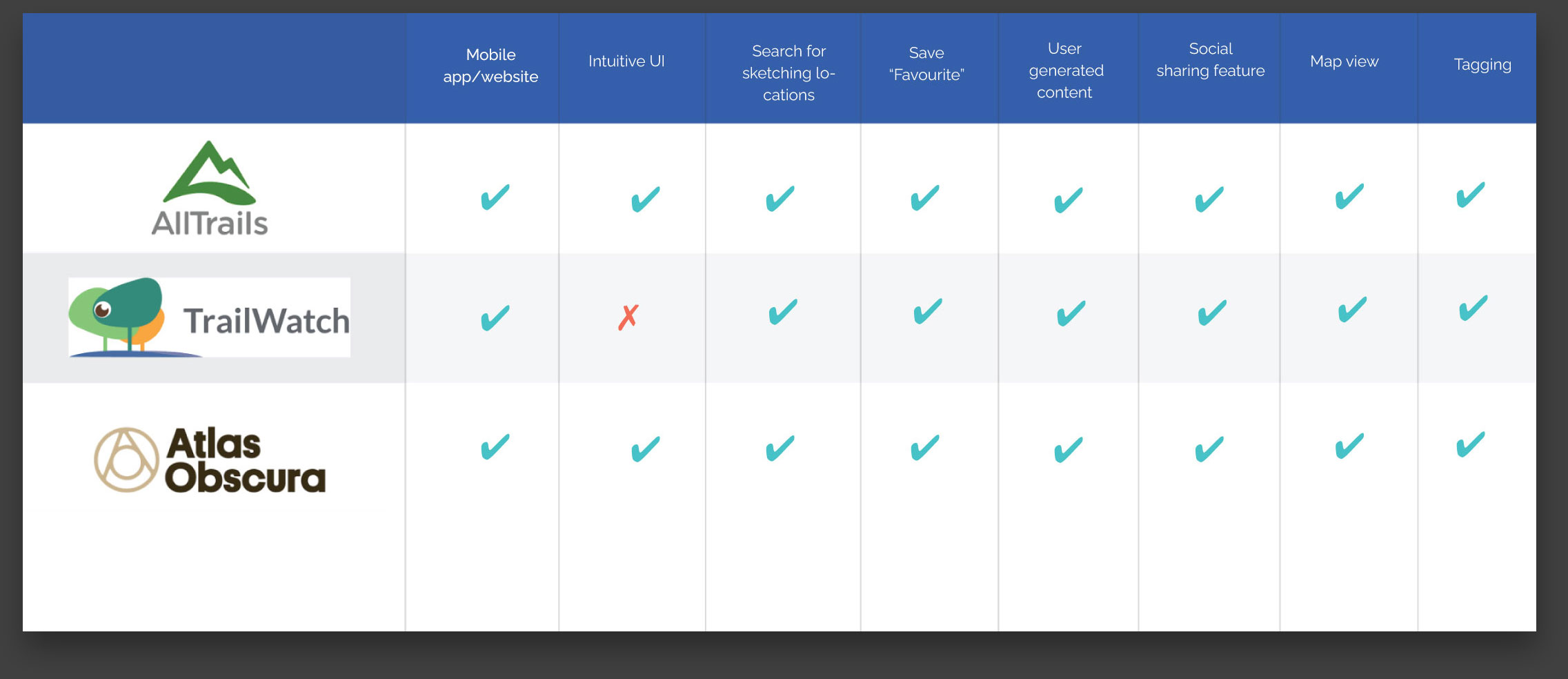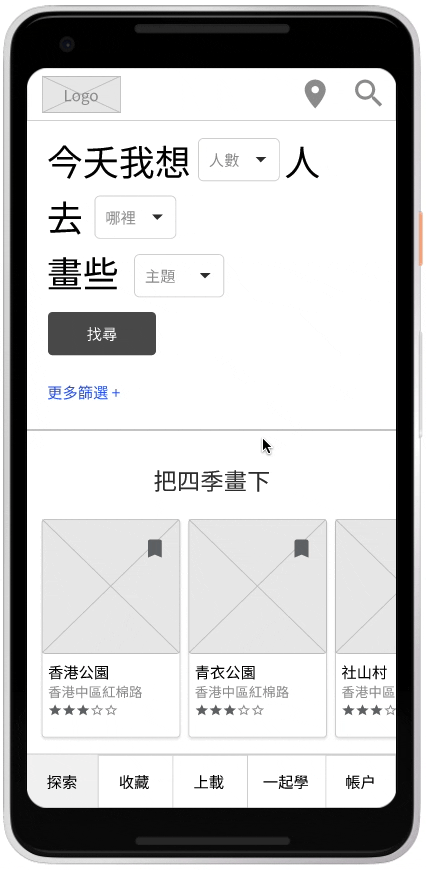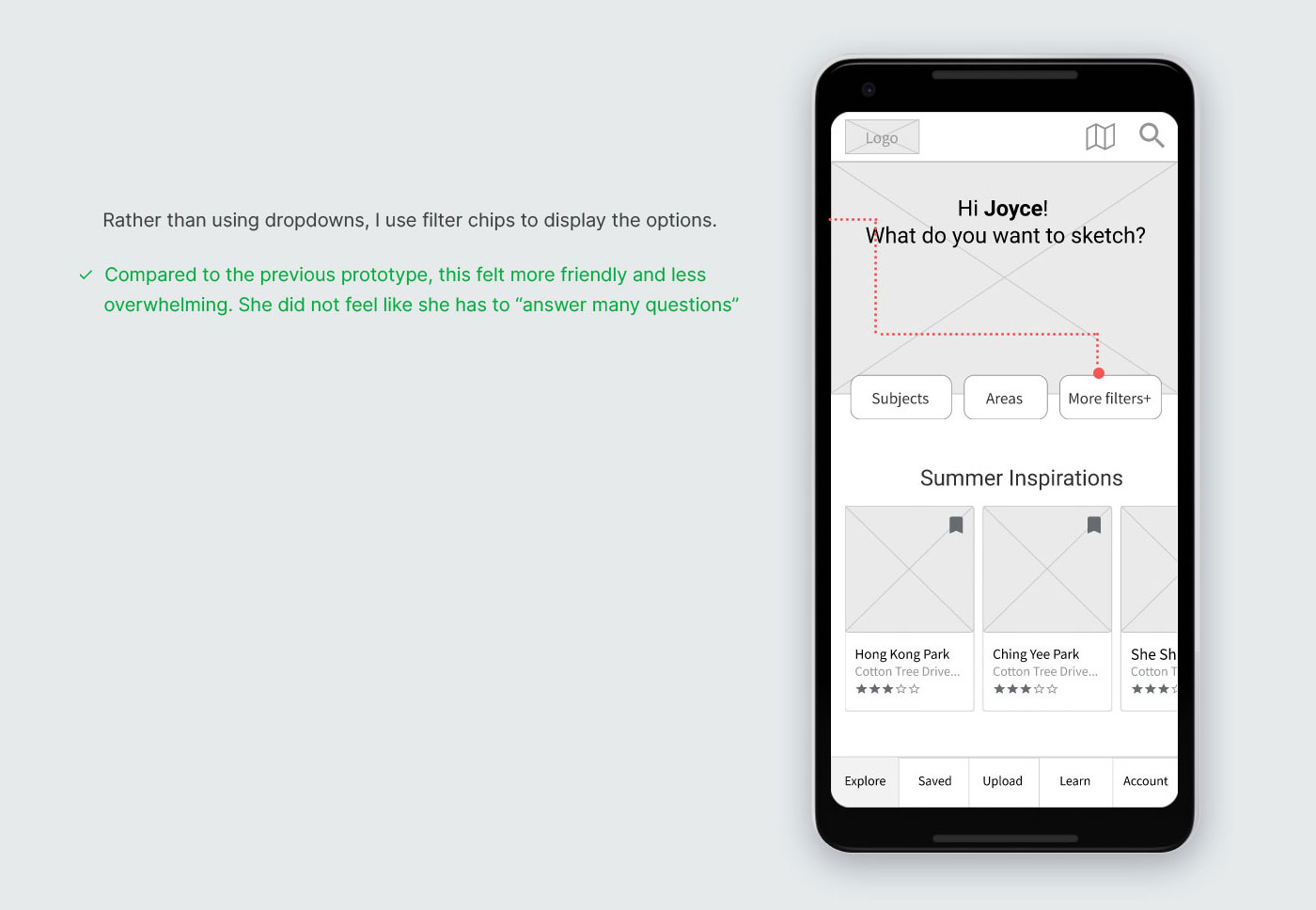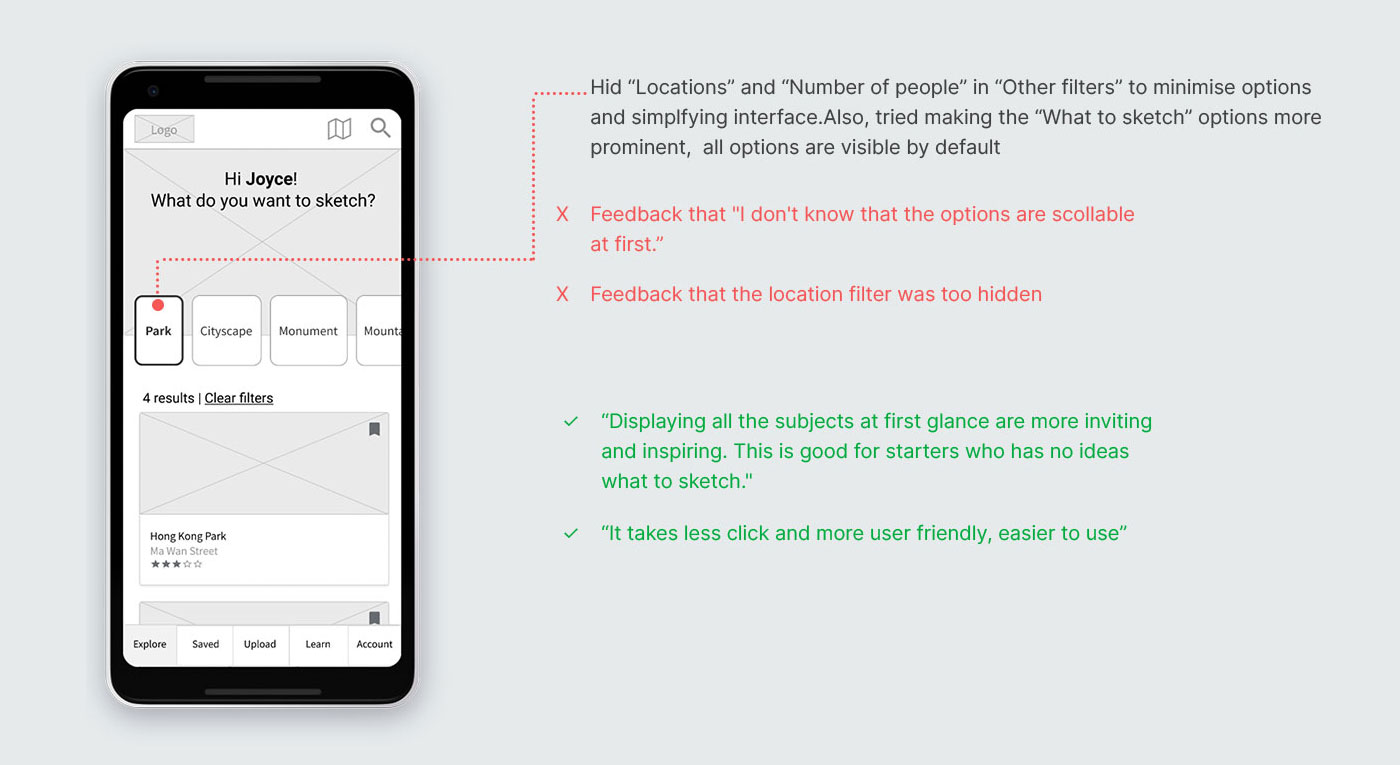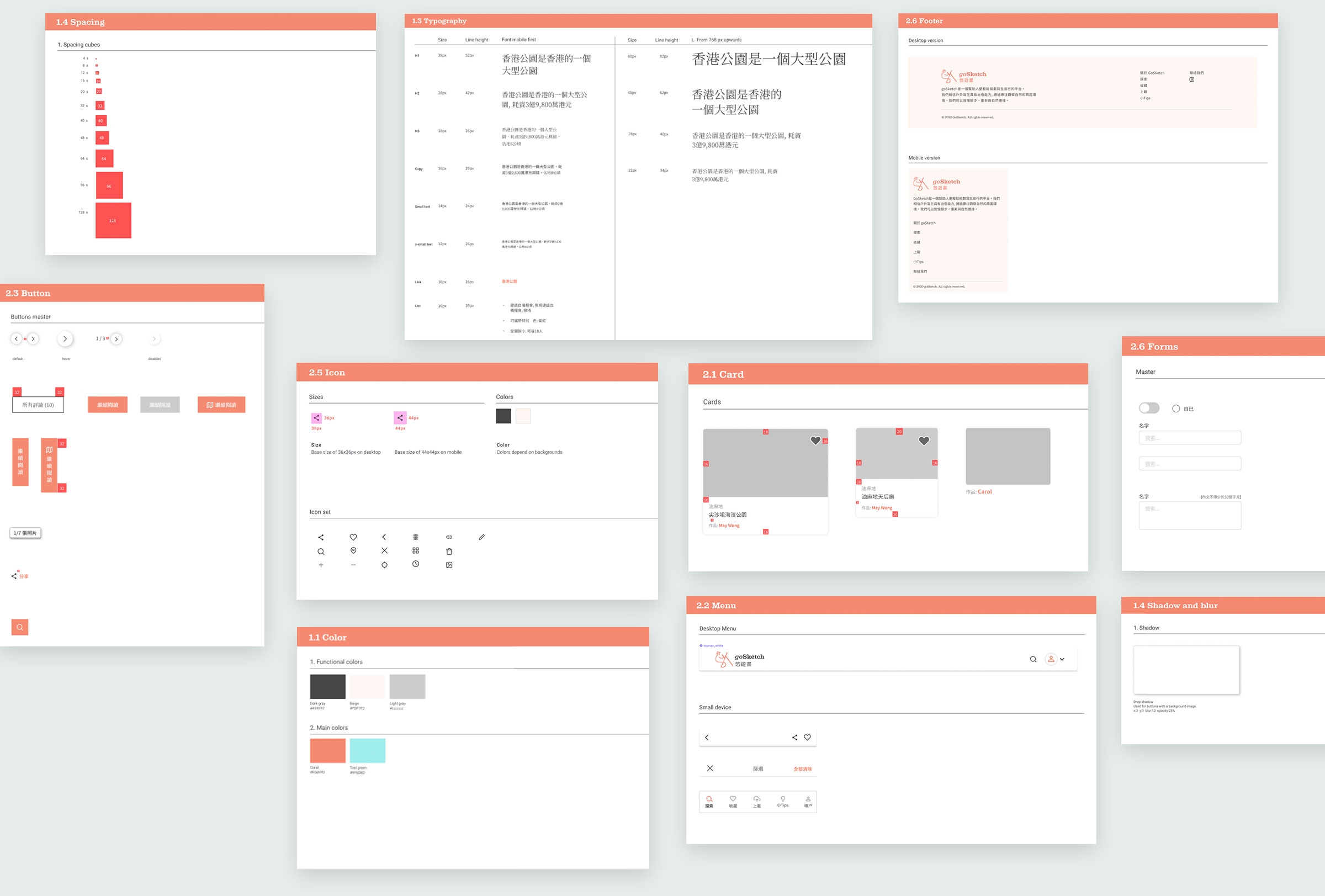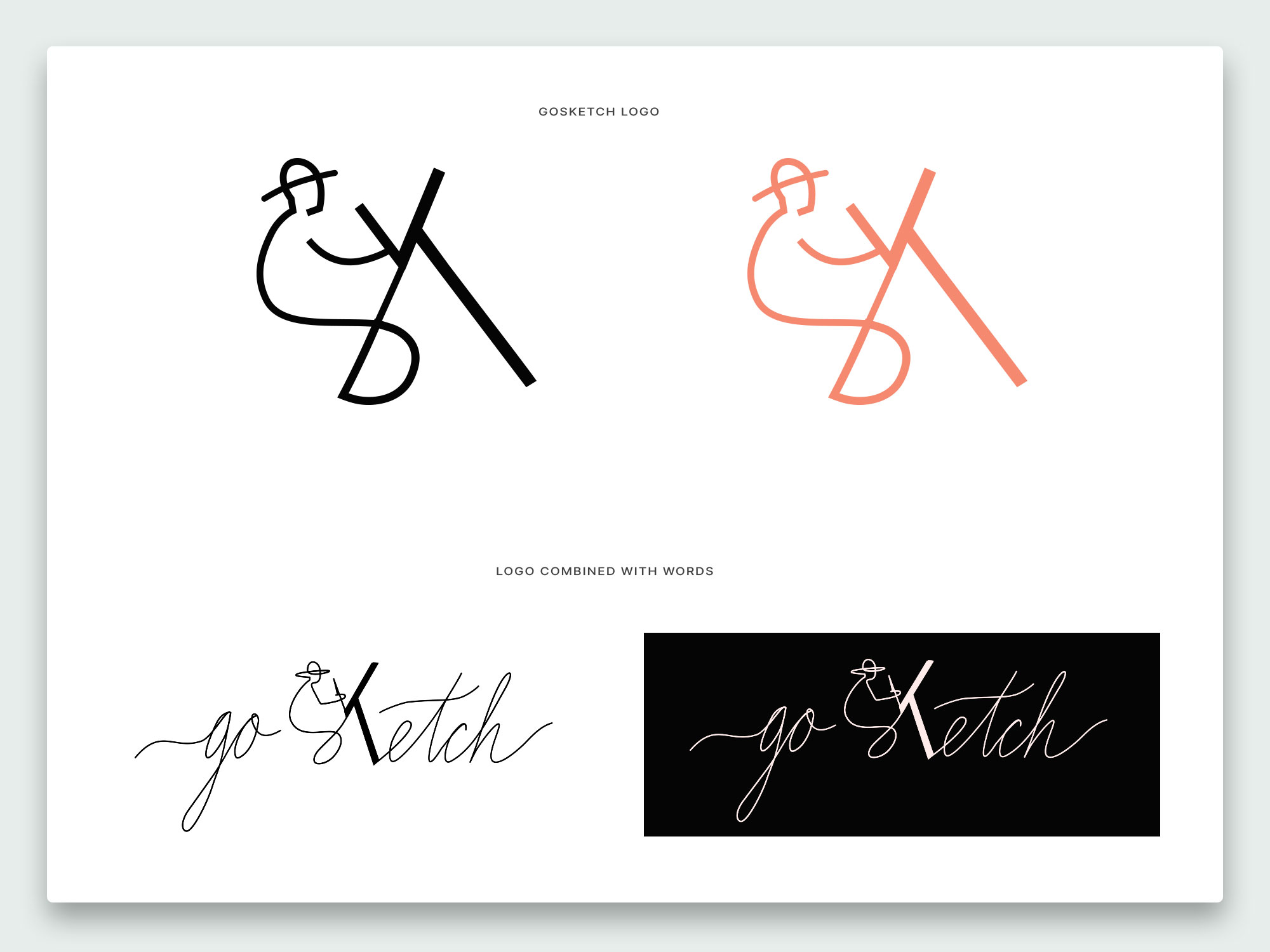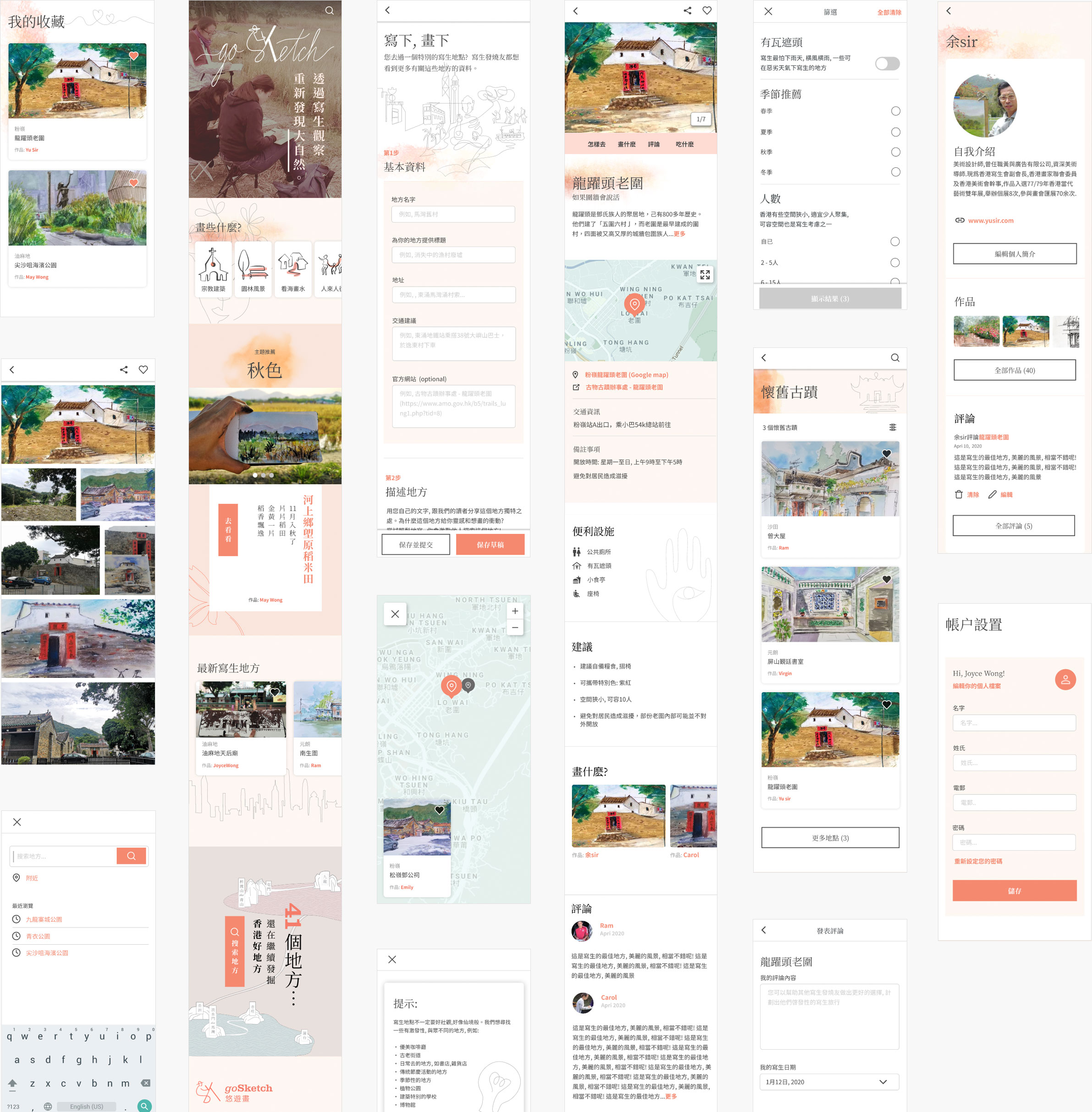GoSketch
How might we help users to look for sketching destinations so they will be more motivated and inspired to sketch outdoor?
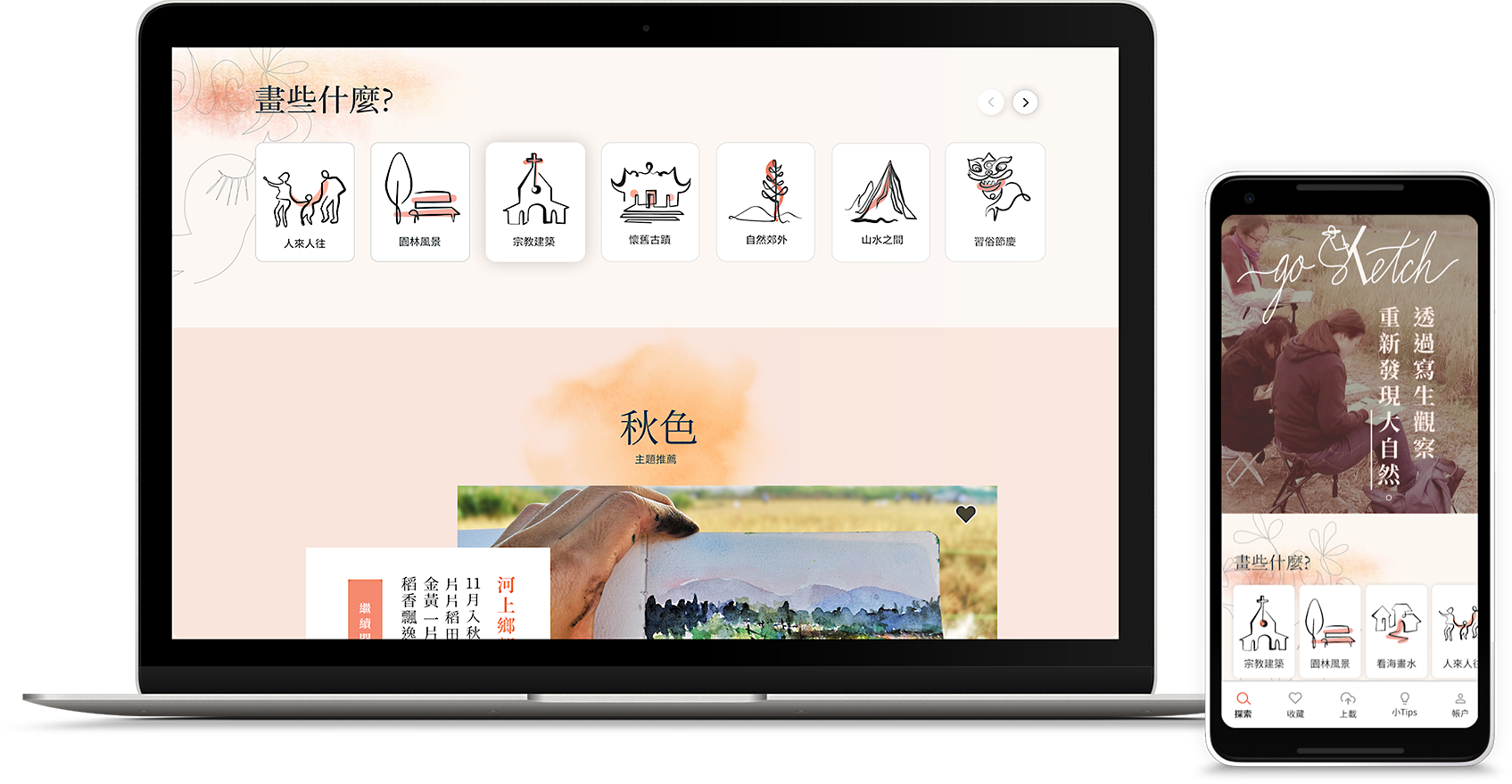

Research indicates that many Hong Kong people are stressed nowadays. We believe that outdoor sketching has healing power. Through observing nature and the environment around us, we slow down, become more focused and reconnect with nature and our inner self.
I would like to create an app that helps people to look for places to sketch outdoor easily. Eventually, it may change the ways we think about the world we live in.
RESPONSIBILITIES
User research and discovery
Competitor research
Persona and user flow
Ideation and prototype
Testing
UI design
System design
Logo and identity design
The Problems
WHERE TO GO? HOW TO START? WHAT TO SKETCH???
People are interested to sketch outdoor but oftentimes they are disoriented and overwhelmed- from choosing a suitable place to getting prepared and figuring out what or how to sketch on site.
PROJECT GOALS
01 To help users to find inspiring places to sketch
02 To let users share their artworks
03 To let users participate and contribute their sketching places
04 To motivate users to sketch by seeing their improvement
05 To encourage beginners to try outdoor sketching by giving them tips
Understanding the Users
CONDUCTING USER INTERVIEWS
To better understand the needs, problems and motivations of the sketchers, I reached out to 3 people who practiced outdoor sketching regularly.
I conducted in-person interviews about these areas:
01 BEFORE THE TRIP
- What to bring? Where to go? How to get there? Who is going with you?
- How do you prepare for a sketching trip?
02 DURING SKETCHING
- What are some of frustrations, difficulties, satisfactions or learnings you have had from sketching outdoor?
03 AFTER THE TRIP
- What do you do with the sketches after the trip?
Key Insights from User Interviews
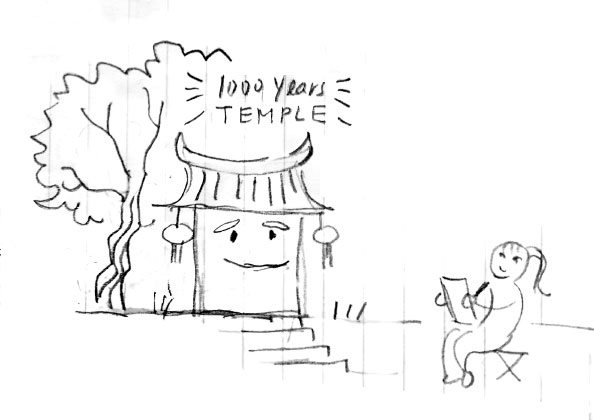
01 THE "PLACE" IS AN IMPORTANT MOTIVATION
Finding a special and meaningful place will inspire and motivate people to sketch outdoors.
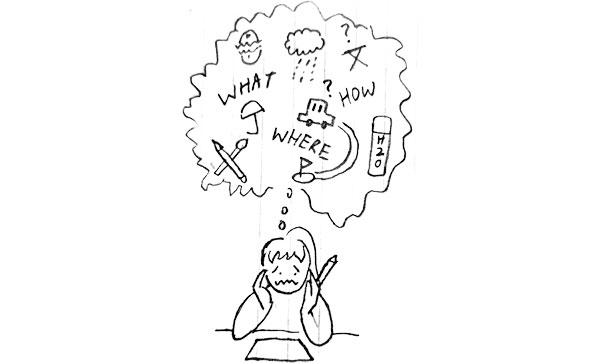
02 PLANNING FOR THE TRIP CAN BE OVERWHELMING
A wide range of factors and elements to consider before the trip: Weather? Water bottle? Food? Art supplies? Paper? Colours? Folding chair? Tripod? Umbrella? There is even more to consider if it becomes a communal event.
Interview replies show that having knowledge of the place prior to the trip helps to reduce anxiety.
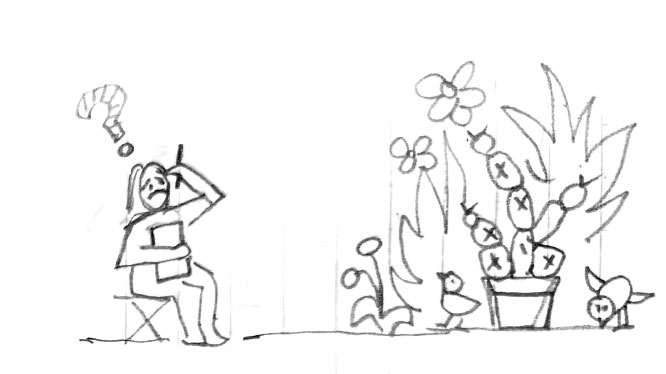
03 FRUSTRATION DURING SKETCHING
Common sources of frustrations include not knowing what to start with, sketches do not turn out as expected, sticking to existing drawing habits, and being afraid to experiment with new mediums
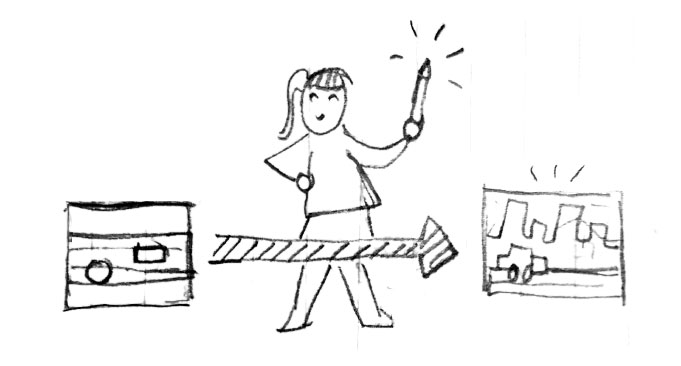
04 WAYS TO OVERCOME FRUSTRATION:SKETCHING AS A PROCESS
People who overcame the above frustrations tend to think of the activity as a relaxing pastime for well-being and mindfulness. It is possible to revisit the place and improve the sketch later, so there is no need to make it perfect at a time. In this way, they can also see their progress and improvement over time.

05 OUTDOOR SKETCHING AS A MIX OF SOLITARY AND SOCIAL EXPERIENCES
The act of sketching is solitary, but the desire to share and give feedbacks to each other’s sketches is a form of social experience.
To them, sketching is not just about making an image. Going on a sketch trip is also an opportunity to experience various kind of culture and sometimes they can enjoy local food and get to know more new friends.
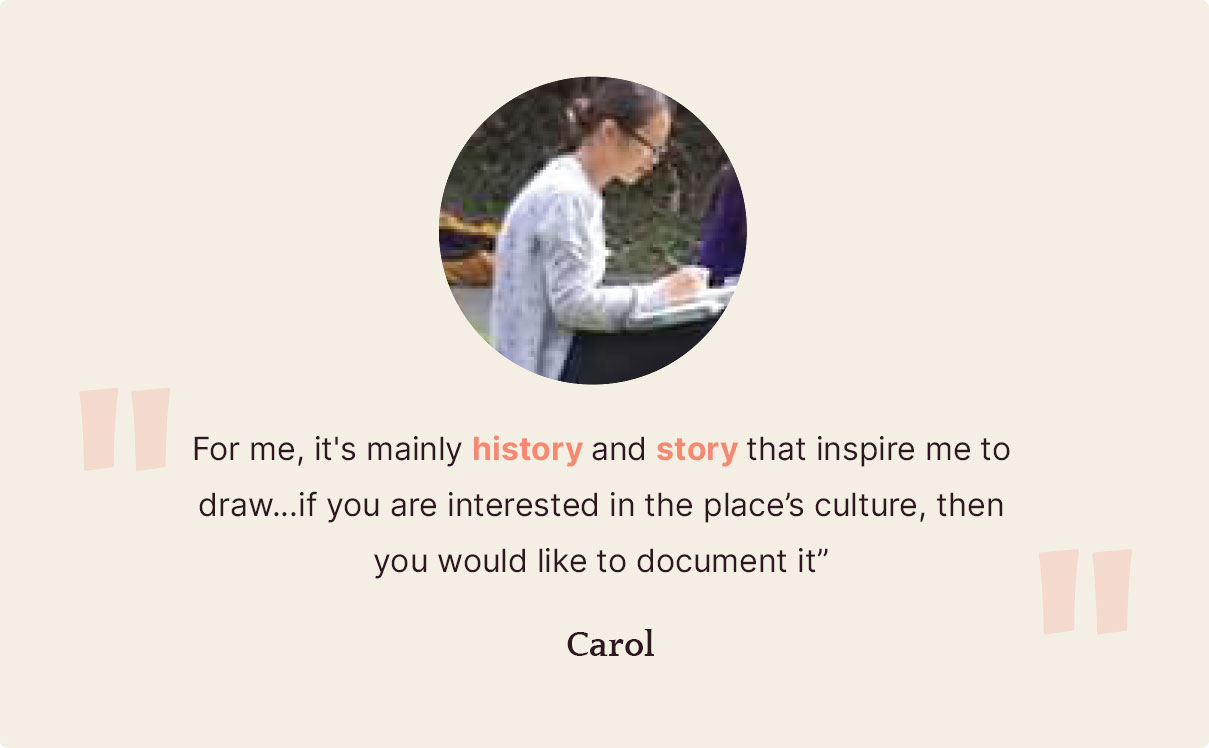
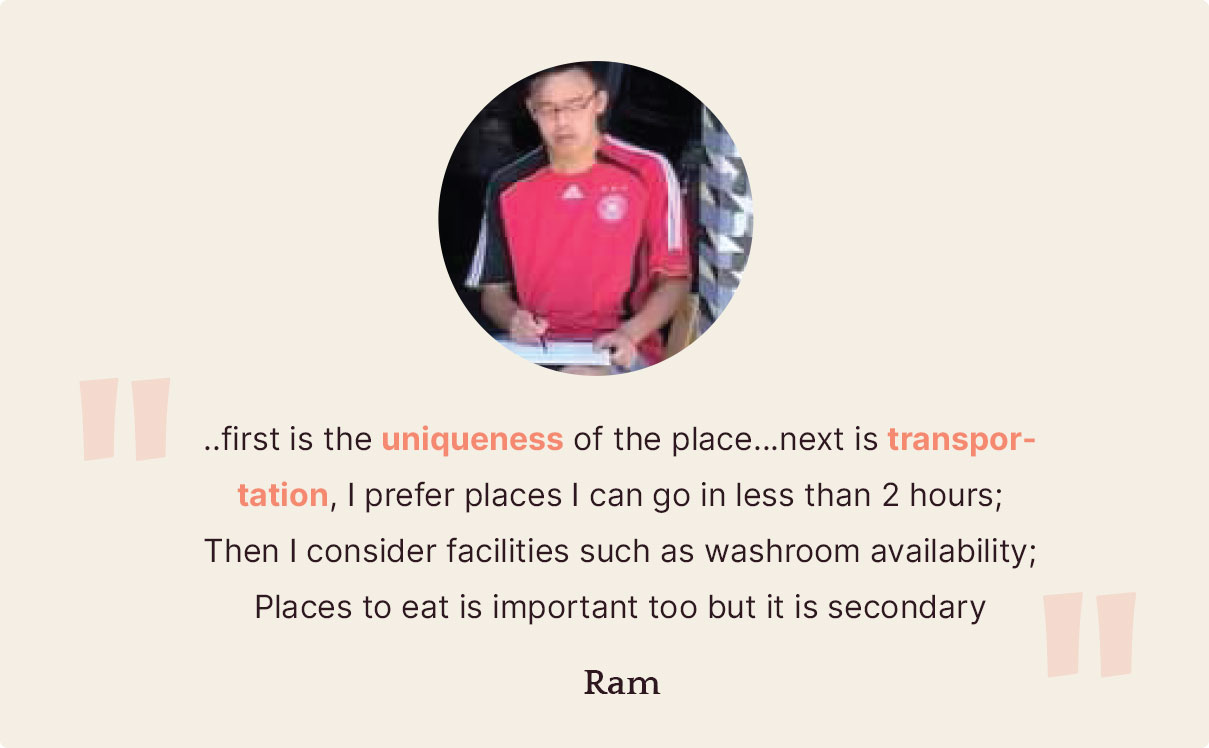
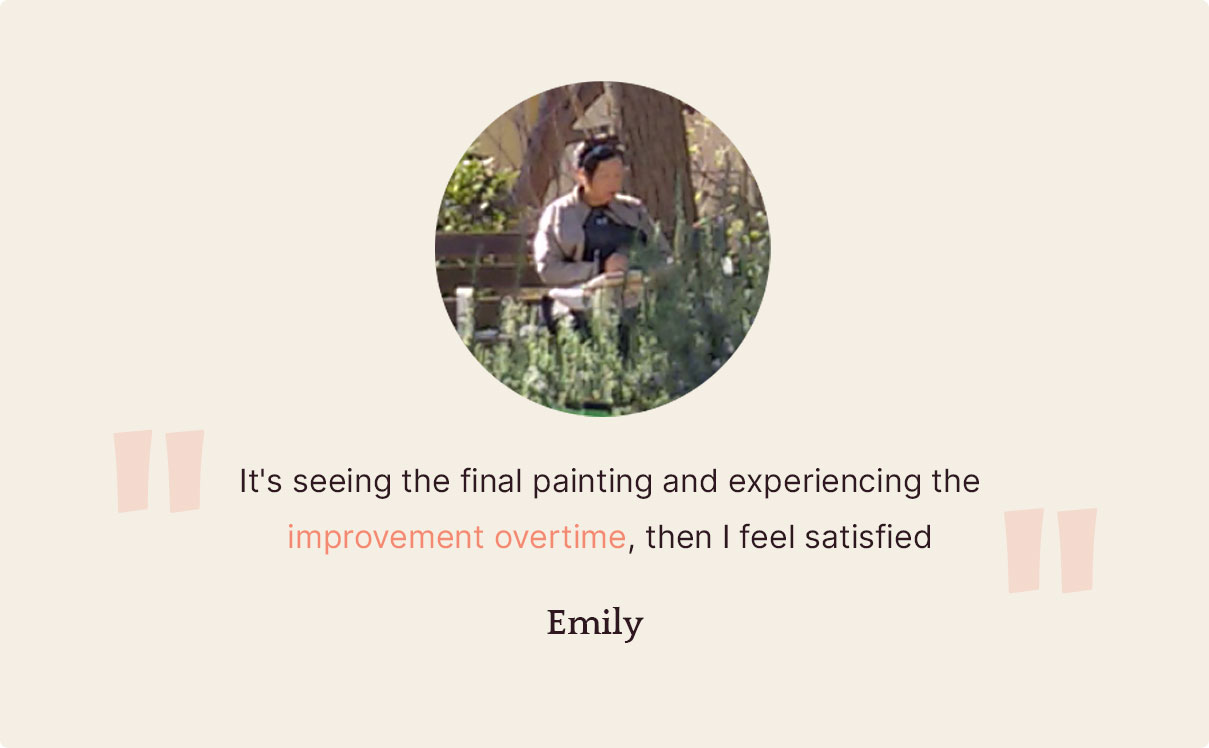
Curating Personas
Based on the user research, 2 personas were developed which helped to focus on user needs and guided my design decisions.
01 CAROL _ A WEEKEND SKETCHER
Carol is an adventurous person who wants to find inspiring places to sketch. She wants to be better prepared before her sketching trip. Due to her busy schedule, she wants to save time searching for places. She also wants to find companions to sketch outdoor together. She likes to look at other's sketches and places they went to sketch.
02 BOB- A RETIRED ART ENTHUSIAST
Bob has retired already and wants to further develop his artistic talents. But due to mobility limitations, he needs to choose the sketching locations carefully. He wants to make sure that the places are easily accessible. He is also cautious about sharing personal information on social media platforms.
User Flows
I focused on the primary persona-Carol whose main obstacle is finding an interesting place to sketch. So I believed that by highlighting inspiring places and enabling the “Search" function, we could motivate her to sketch outdoor.
Competitive Analysis
INSIGNTS FROM DIRECT COMPETITORS
01. They don’t have a very strong online presence. Some rely on Facebook Page solely, using that as their websites.
02. Opportunities: They emphasize the art and community aspects, but do not offer much help on finding sketching locations and inspirations.
03. Information is not well organized and is hard to find.
So I tried to look for indirect competitors for more inspiration. I looked at hiking apps such as AllTrails and TrailWatch for ideas about browsing for information, sharing user's reviews and trip planning.
The research reassured my intention to focus on helping people to “Find places for Sketching” in Hong Kong, a goal that differentiates us from other competitors.
Paper Prototyping
I tried to quickly validate my design flows with a paper prototype. I ran the test with 3 users. Below were the tasks of the test:
01 Use the sketching app to find a place where you would like to sketch outdoor on a Sunday morning
02 After that, you would like to invite Mary to sketch with you
FEEDBACKS
- “I care more about the theme and what to draw, rather than the location.”
Users had different ways of looking for places. At first, I assumed users would mainly search by keyword; After the test, I found out that was not the case. Some users preferred using “Browse" over “Search" function; some wanted to be able to search places nearby; some wanted to discover new destinations the sketchers had never been to. - “I would like to upload my works and look at other’s works and reviews.”
Users wanted more user-generated content and participation. - “I don’t need all these filters. Filter such as “weather" does not make sense”
The filter design looked complicated and it was hard to choose from.
Iterate with Wireframe
I started wireframing to bring more clarity to the design flow. I made iterations based on the feedbacks received from the paper prototype. I showed them to the users again to get more feedbacks.
SEARCH & FILTER
Recognizing the need to let users “browse” for places, I introduce "dropdown" where users can make selections about the place. I also tried to minimise the importance of the search bar.
FEEDBACK
Major issues were found with the dropdown UI:
- Usability -Users were expected to see different menus when clicking the dropdown fields. The prototype showed a filter page which did not really make sense.
- The conversational UI pattern was hard to use - It required too many steps. They had to first tap on the dropdown to open a menu of options, then scrolled and scanned through the items to select one, and then closed the menu to get back to the homepage.
- Confusion - Do I need to select all three drop-downs before I search? What if I don't select any dropdown and click the “search” button?
Iterate, Iterate, Iterate...
Feedback from the usability testing led to more iterations, usability fixing and interaction fine-tunings.
Visual Design
I revised the prototype based on the feedbacks. Meanwhile, I started working on the visual design.
For colors, I kept them light and understated, so that users could focuse more on the artwork itself.
For typography, I picked Noto Serif for headers for its elegance and more artistic look. In contrast, I used Noto San for body text for its legibility and simplicity.
Responsive Experience
WHY MOBILE FIRST?
The "mobile-first" approach was taken, as most of the users used their cell phones when searching for information about sketching places. However, some users also mentioned that they used tablets and laptops in addition to mobile.
I ensured that it functioned well on other devices. A total of 3 breakpoints were designed in Figma.
GOSKETCH HOME PAGE
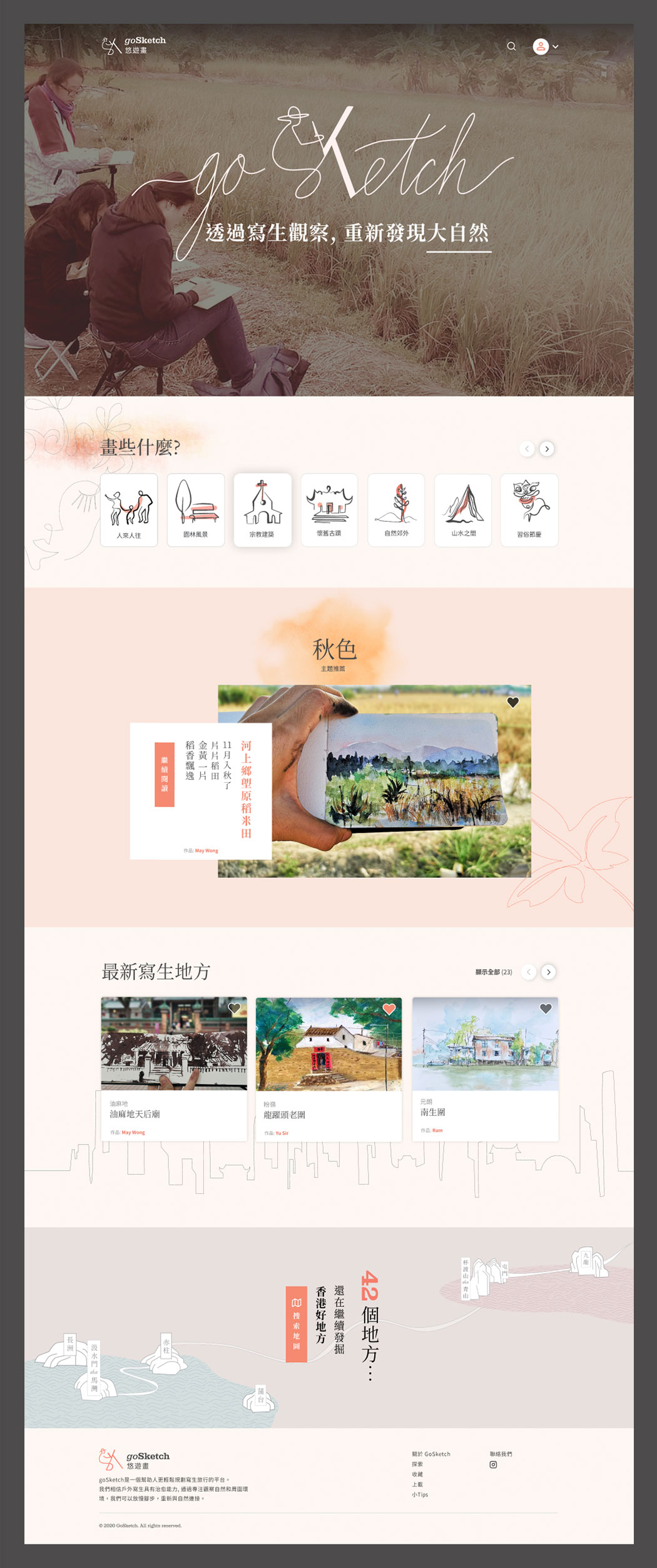
"PLACE" DETAILED PAGE
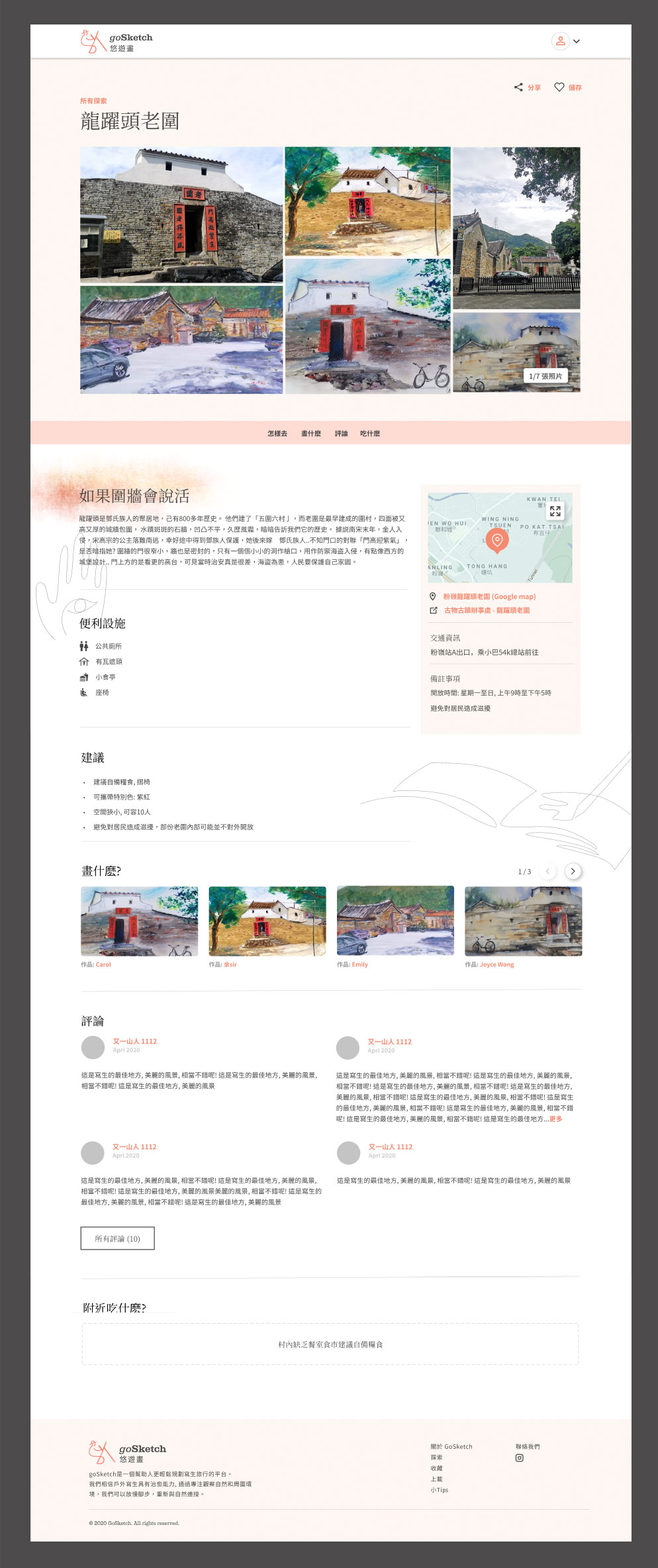
"ADD A PLACE" PAGE
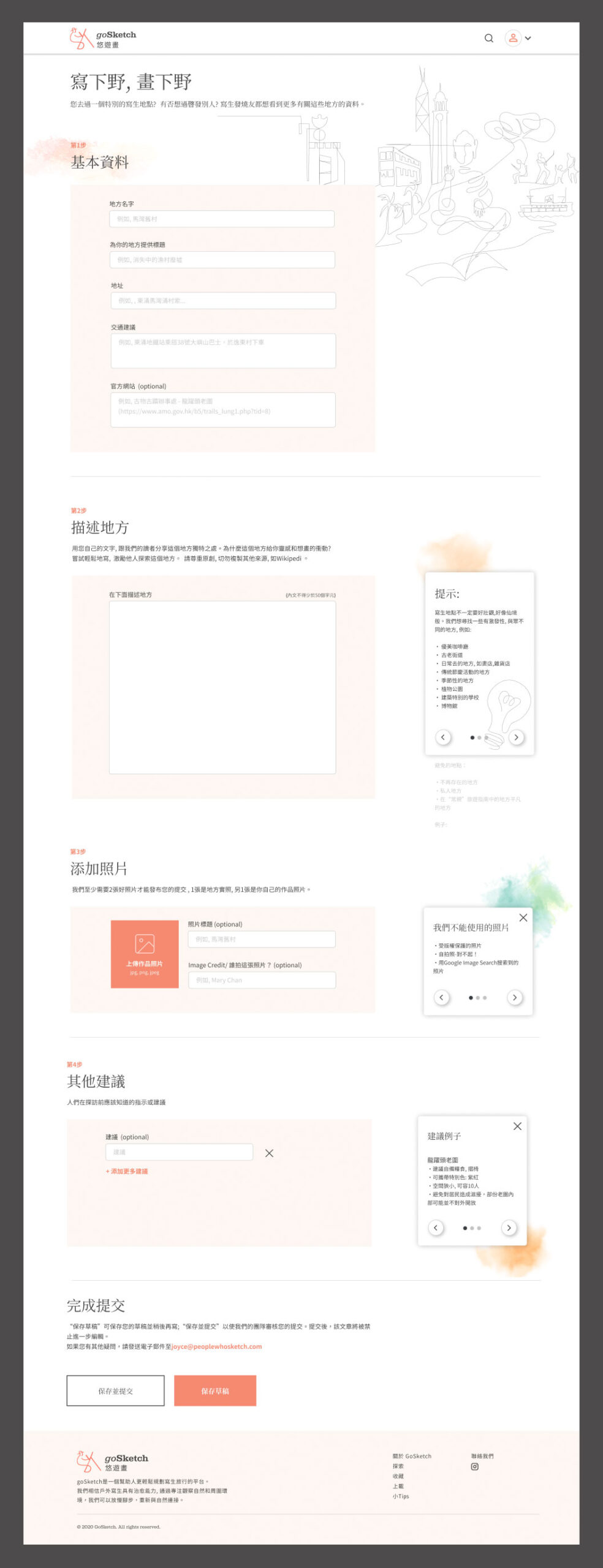
LISTING PAGE
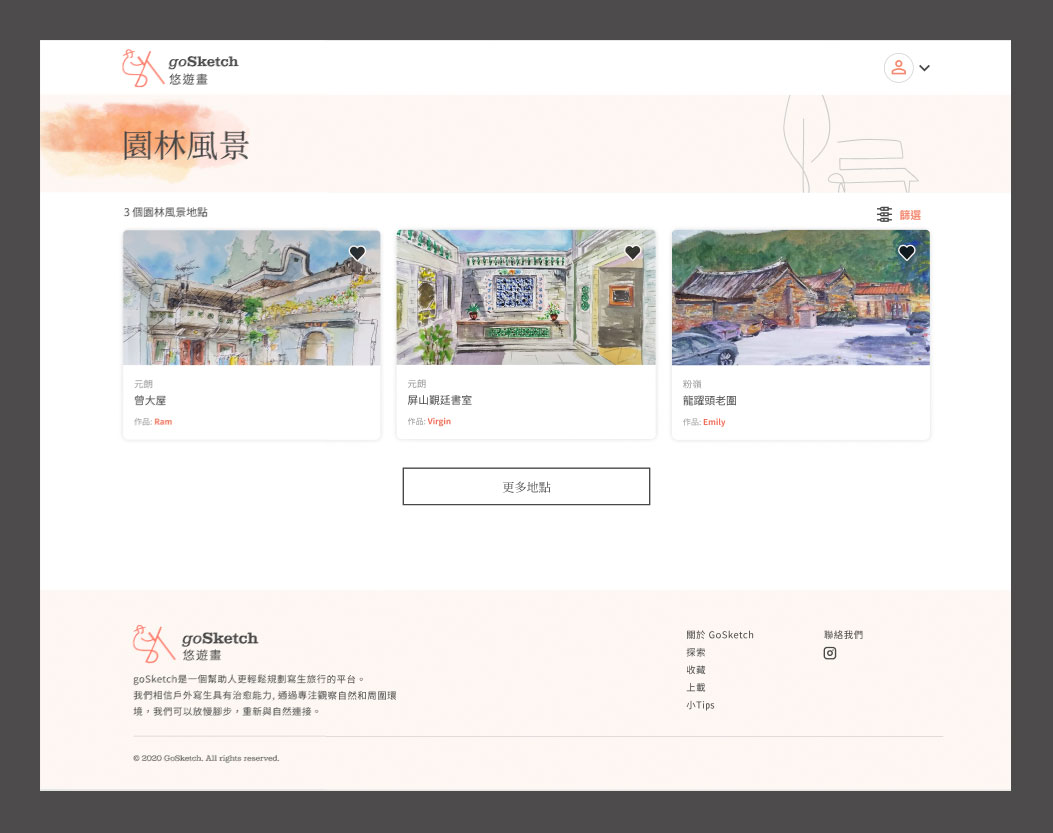
PROFILE PAGE
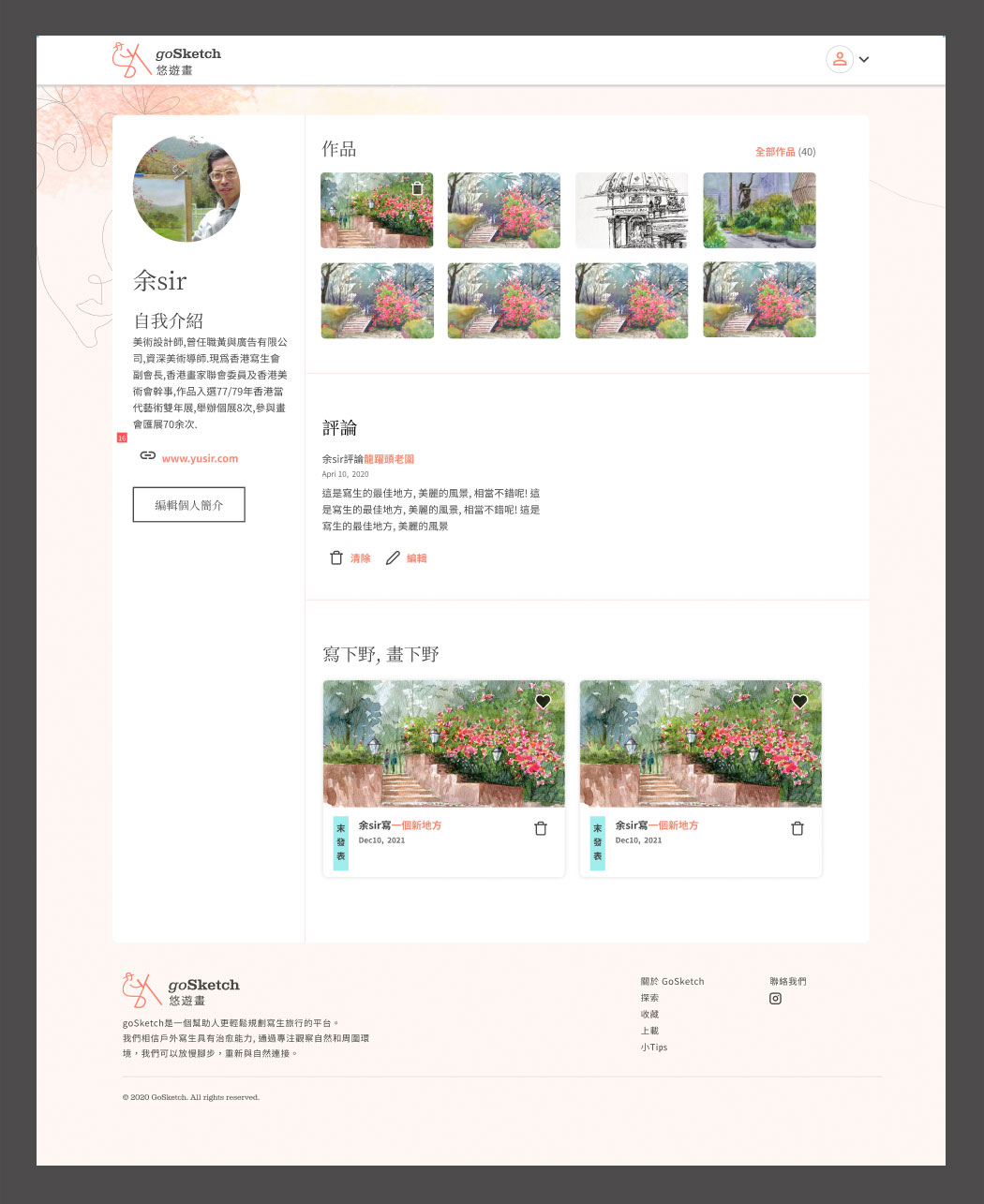
ACCOUNT PAGE
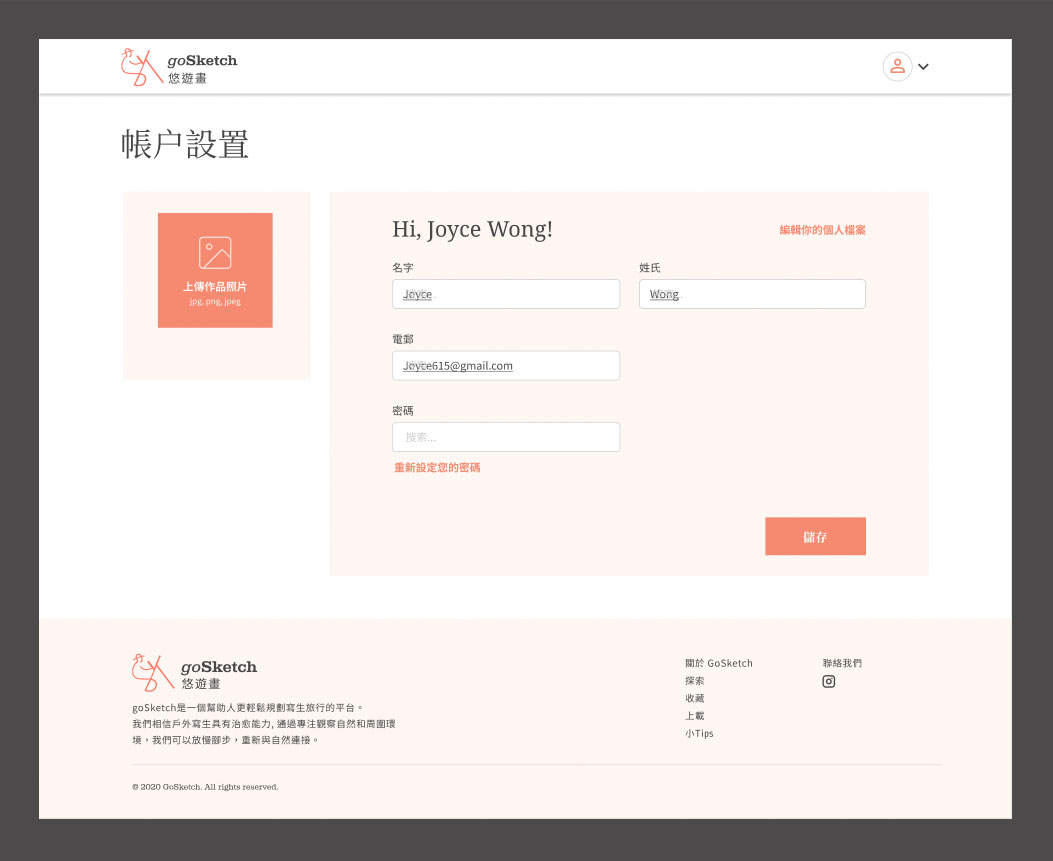
Learnings
01 LEARNED TO EMPATHIZE
This projects makes me reflect on what it takes to be empathetic. I don't think I am particularly empathetic, I come from a graphic design background, and designs can be very ego-centric. I was trained to do works that "wow". I think I am good at it and I have learned a lot from doing branding, identities and advertising. It was a little discomforting for me at the beginning- to take a non-judgemental mindset when doing user researches and usability testing. I have learned to hold the space for user’s perspectives regardless of what they said, whether the response is positive or negative. I have to tell myself that I am here to learn and I am coming up with a design that works for others, but not only for myself.
It is challenging but I enjoy being a researcher. It is not easy to open up a space and invite people to fill it with their thoughts, feelings, experiences and perspectives. It is a great art and skill- how to get the trust of another human being and invite them to share their experiences with you? Then during the interview, how to stay open-minded and not be dictative over what the interviewee says during an interview? It is almost like therapy. I am very surprised by what the participants shared with me. They opened up things that I didn't expect them to open up.
02 NEXT STEPS
This project is very much like a hobby to me. After the first cycle of learning - designing and validating, I would like to pitch this project to potential partners to build the MVP. I don't want it to be just a design showcase, I want to turn it into a real product that helps sketchers and people to feel better through outdoor sketching.
MID-TERM PLAN
- To start working and collaborating with a developer who is interested in this project
- To iterate more usability tests with new users
LONG-TERM PLAN
There are still many ideas and assumptions that I would like to try and test out . For instance, how to motivate sketchers to keep sketching and improving their skills in the long run? How to engage the sketchers in outdoor sketching so it becomes a natural habit to them? How about an app that helps to a habit?
I think what I have here is just a start...
